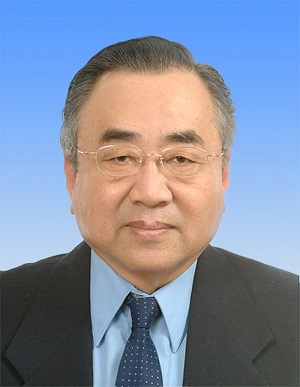
Wenrui Chang, Ph.D, Prof., CASM
-
Principal Investigator
State Key Laboratory of Biomacromolecules, IBP
Research Interests: Structural and functional analysis of biomacromolecules
Email: wrchang@ibp.ac.cn
Tel: 010-64888512
Address: 15 Datun Road, Chaoyang District, Beijing, 100101, China
Chinese personal homepage
- Biography
1960 - 1964 Nankai University, China, B.Sc. in Chemistry
1990 - Investigator, Institute of Biophysics, Chinese Academy of Sciences.
2005 - Member of Chinese Academy of Sciences
- Awards
National Natural Science Awards, Second Rank, 1982
CAS Science &Technology Progress Awards, First Rank,1987
National Natural Science Awards, Second Rank, 1989
Science and TechnologyAwards of Beijing, First Rank, 2004
Ho Leung Ho LeePrize, 2004
Chinese Academy of Sciences Distinguished Scientific Achievement Award, 2005
cience and TechnologyAwards of Beijing, First Rank, 2013
National Natural Science Awards, Second Rank, 2014
- Membership in Academies & Societies
- Research Interests
Prof. Chang is working on the structural and functional analysis of biomacromolecules (including Insulin, Earthworm FibrinolyticEnzymes, Metalloproteins, Phycobiliproteins and etc.) for many years. For the past decades, the main research focus of our group is on structural studies of photosynthesis related proteins. Photosynthesis, which is one of the most important chemical reactions in the world, occurs in two stages: light reactions and dark reactions.Investigation on the two themes are as following:
I. Structural and functional analysis of photosynthesis membrane proteins related to the light reactions:
1. PSII-LHCII supercomplex from higher plants
Higher plant PSII-LHCII is a supramolecular machineryembedded in thylakoid membranes. PSII-LHCII is a dimeric supercomplex, each monomer is composed of more than thirty protein subunits and binds hundreds of pigments, cofactors and lipids.Plant PSII comprises a dimeric core associated with various light-harvesting complexes (LHCIIs), formingPSII-LHCII supercomplexes in different combinations and with different size. Structural determinations of these supercomplexes will enable us to reveal the molecular mechanism of efficient light harvesting and energy conversion of plant PSII. For deeper understanding the molecular mechanism of photosynthesis, we have carriedout the structural analysis of differentPSII-LHCII supercomplexes from higher plants.
2. Structural and functional analyses of supercomplexes involved in photo-protection and photosynthetic regulation
Photosynthesis is a dynamically regulated process driven by sun light. Under high light conditions or other environmentalstresses, plants often absorb more light energy than they can use for carbon dioxide assimilation. The excessively absorbed light energywill cause photo-oxidative damage to plants. To avoid or reduce photo-damage, plants and algae have evolved multiple protective and regulatory mechanisms, including energy dependent quenching (qE), whichcan safely dissipate excess excitation energy as heat; state transitions (qT), which can balance energy distribution between two photosystems; cyclic electron transfer (CET), which can optimize photosynthetic efficiency; and etc. Various supercomplexes are formed during these regulatory processes. To deeply explore the molecular mechanisms of photo-protection and photosynthetic regulation, wehave carried out the structural analyses of these different supercomplexes from higher plants and green algae.
II. Structural and functional analysis of important enzymes and protein complexes related to photosynthesis.
1. Key enzymes and protein complexes involved in the dark reactions
During photosynthesis, ATP and NADPHgenerated in the light reactions take part in the Calvin cycle, in order to fix carbon dioxide and produce carbohydrates. While in the dark, plants can use normal catabolic processesas do non-photosynthetic organisms. The stromain the chloroplasts contains both assimilatoryenzymes of the Calvin cycle and dissimilatoryenzymes.These enzymes are regulated in a light-dark dependent manner.Multiple enzymes and protein complexes are involved in these light-dark regulatory processes. We have carried out the structural analyses of these proteins and protein complexes.
2. Fatty aldehyde decarbonylase from cyanobacteria
Developing an engineered photosynthesis microbe to produce biofuels directly, by using the method and technology of molecular biology and synthetic biology, is an important direction for developing renewable clean energy. Fatty alkane, which is called “bio oil”, is an ideal substitute product for conventional liquid fuel. The fatty alkane metabolism pathway in cyanobacteria was discovered in 2010. We have carried out series structural and functional analysis of key enzymes in this pathway from different species of cyanobacteria.
- Grants
- Selected Publications
1. PanX, MaJ, SuX, CaoP, ChangW, LiuZ, ZhangX*, MeiLi*;Structure of the maize photosystem I supercomplex with light-harvesting complexes I and II. Science. 2018;360(6393):1109-1113
2. Su X1, Ma J1, Wei X1, Cao P1, Zhu D, Chang W, Liu Z*, Zhang X*, Li M*. Structure and assembly mechanism of plant C(2)S(2)M(2)-type PSII-LHCII supercomplex. Science. 2017, 357(6353):815-820.
3. Wei X1, Su X1, Cao P, Liu X, Chang W, Li M*, Zhang X*, Liu Z*. Structure of spinach photosystem II-LHCII supercomplex at 3.2 Å resolution. Nature. 2016, 534(7605):69-74.
4. Fan M, Li M*, Liu Z, Cao P, Pan X, Zhang H, Zhao X, Zhang J, Chang W*. Crystal structures of the PsbS protein essential for photoprotection in plants. Nature Structural & Molecular Biology, 2015, 22(9):729-735.
5. Cao P1, Xie Y1, Li M*, Pan X, Zhang H, Zhao X, Su X, Cheng T, Chang W*. Crystal Structure Analysis of Extrinsic PsbP Protein of Photosystem II Reveals a Manganese-Induced Conformational Change. Molecular Plant, 2015,8, 664–666.
6. Wan T, Li M*, Zhao X, Zhang J, Liu Z, Chang W*. Crystal structure of a multilayer packed major light-harvesting complex: implications for grana stacking in higher plants. Mol Plant. 2014 May;7(5):916-9.
7. Pan X, Liu Z*, Li M, Chang W*. Architecture and function of plant light-harvesting complexes II. CurrOpinStruct Biol. 2013 Aug;23(4):515-25.
8. Pan X., Li M., Wan T., Wang L., Jia C., Hou Z., Zhao X., Zhang J., Chang W*. Structural insights into energy regulation of light-harvesting complex CP29 from spinach. Nature structural & molecular biology 2011, 18, 309-315
9. Pascal A. A., Liu Z., Broess K., van Oort B., van Amerongen H., Wang C., Horton P.*, Robert B.*, Chang W., Ruban A. Molecular basis of photoprotection and control of photosynthetic light-harvesting. Nature 2005, 436, 134-137
10. Liu Z., Yan H., Wang K., Kuang T., Zhang J., Gui L., An X., Chang, W*. (2004) Crystal structure of spinach major light-harvesting complex at 2.72 Å resolution. Nature 428, 287-292.
(From Wenrui Chang, January 21, 2019)

